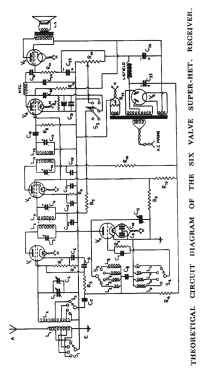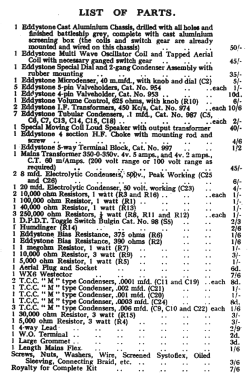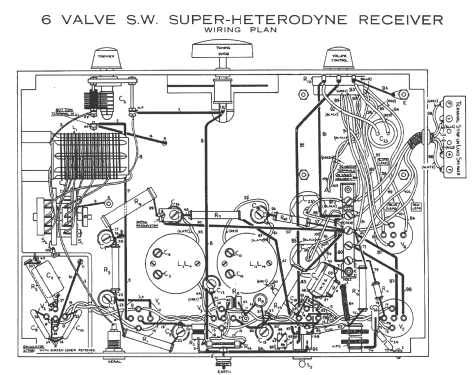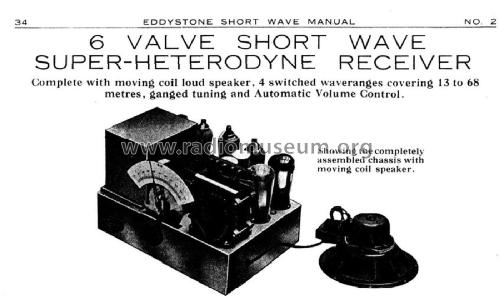Six-Valve Shortwave Superheterodyne
Eddystone (Brand), Stratton and Co., Ltd., Eddystone Radio Ltd.; Birmingham
- País
- Gran Bretaña (GB)
- Fabricante / Marca
- Eddystone (Brand), Stratton and Co., Ltd., Eddystone Radio Ltd.; Birmingham
- Año
- 1935 ?
- Categoría
- Kit (Partes con instruciones) o Solo Instrucciones
- Radiomuseum.org ID
- 355308
Haga clic en la miniatura esquemática para solicitarlo como documento gratuito.
- Numero de valvulas
- 6
- Numero de transistores
- Semiconductores
- WX6
- Principio principal
- Superheterodino en general
- Gama de ondas
- Onda Corta solamente
- Tensión de funcionamiento
- Red: Corriente alterna (CA, Inglés = AC)
- Altavoz
- Altavoz electrodinámico (bobina de campo)
- Material
- Metálico con lámparas a la vista.
- de Radiomuseum.org
- Modelo: Six-Valve Shortwave Superheterodyne - Eddystone Brand, Stratton and
- Forma
- Chasis (tambien de autoradio)
- Anotaciones
-
Six-Valve Shortwave Superheterodyne Kitset: Detailed Breakdown
This kitset offers a complete shortwave radio experience, featuring:
- Six Valves: This includes a full-wave rectifier for power conversion and a metal rectifier for automatic volume control (AVC).
- Superheterodyne Design: It employs the superheterodyne principle, converting received signals to a fixed intermediate frequency (IF) for easier amplification and filtering.
Signal Processing Stages:
- First Detector: A screened-grid valve functions as an anode-bend rectifier, converting the received radio signal to an IF signal.
- Local Oscillator: A separate triode valve generates the necessary oscillation signal for frequency mixing in the superheterodyne process.
- Intermediate Frequency (IF) Amplifier: A variable-mu-screened pentode amplifies the IF signal at a fixed frequency of 450 kHz.
- Second Detector: A screened high-frequency pentode with power grid rectification demodulates the IF signal to recover the audio information. This stage uses resistance coupling to connect to the output valve.
- Output Stage: A directly heated pentode valve provides power amplification for the audio signal.
Tuning and Controls:
- Ganged Tuning: A ganged capacitor simplifies tuning by adjusting both the antenna circuit and oscillator simultaneously across four-wave ranges. A small trimmer capacitor fine-tunes the antenna circuit for optimal reception.
- Four Wave Ranges: The switchable wave ranges cover a broad spectrum from 13 to 68 metres, approximately 21.4 to 4.4 MHz.
- Automatic Volume Control (AVC): An AVC circuit with a dedicated metal rectifier (WX6) automatically adjusts the gain to maintain consistent audio volume even with varying signal strengths. A switch allows you to bypass the AVC and use a manual volume control for more precise adjustments.
Construction Details:
- Robust Chassis: The receiver, including the power supply, is built on a sturdy cast aluminum alloy chassis, providing a reliable foundation for assembly.
- Effective Shielding: The coil unit utilizes a one-piece metal casting to shield the oscillator circuit, minimizing unwanted signal interactions (interlocking).
- High-Quality Transformer: The mains transformer is designed for exceptional performance, ensuring good voltage regulation without overheating.
Further Information:
This kitset was comprehensively described in Eddystone Shortwave Manual No. 2 (1935), on pages 34-38.
- Mencionado en
- - - Manufacturers Literature (Eddystone Shortwave Manual No. 2 1935, Pages 34 - 38)
- Autor
- Modelo creado por Gary Cowans. Ver en "Modificar Ficha" los participantes posteriores.
- Otros modelos
-
Donde encontrará 255 modelos, 125 con imágenes y 46 con esquemas.
Ir al listado general de Eddystone (Brand), Stratton and Co., Ltd., Eddystone Radio Ltd.; Birmingham



